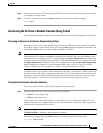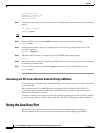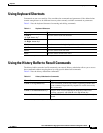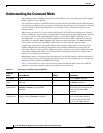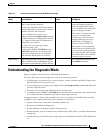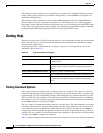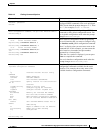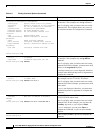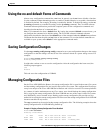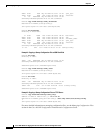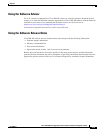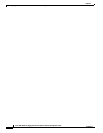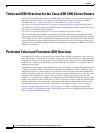
2-11
Cisco ASR 1000 Series Aggregation Services Routers Software Configuration Guide
OL-16506-17
Chapter 2
Using the no and default Forms of Commands
Using the no and default Forms of Commands
Almost every configuration command has a no form. In general, use the no form to disable a function.
Use the command without the no keyword to re-enable a disabled function or to enable a function that
is disabled by default. For example, IP routing is enabled by default. To disable IP routing, use the no
ip routing command; to re-enable IP routing, use the ip routing command. The Cisco IOS software
command reference publications provide the complete syntax for the configuration commands and
describe what the no form of a command does.
Many CLI commands also have a default form. By issuing the command default command-name, you
can configure the command to its default setting. The Cisco IOS software command reference
publications describe the function of the default form of the command when the default form performs
a different function than the plain and no forms of the command. To see what default commands are
available on your system, enter default ? in the appropriate command mode.
Saving Configuration Changes
Use the copy running-config startup-config command to save your configuration changes to the startup
configuration so that the changes will not be lost if the software reloads or a power outage occurs. For
example:
Router# copy running-config startup-config
Building configuration...
It might take a minute or two to save the configuration. After the configuration has been saved, the
following output appears:
[OK]
Router#
This task saves the configuration to NVRAM.
Managing Configuration Files
On the Cisco ASR 1000 Series Routers, the startup configuration file is stored in the nvram: file system
and the running-configuration files are stored in the system: file system. This configuration file storage
setup is not unique to the Cisco ASR 1000 Series Routers and is used on several Cisco router platforms.
As a matter of routine maintenance on any Cisco router, users should backup the startup configuration
file by copying the startup configuration file from NVRAM onto one of the router’s other file systems
and, additionally, onto a network server. Backing up the startup configuration file provides an easy
method of recovering the startup configuration file in the event the startup configuration file in NVRAM
becomes unusable for any reason.
The copy command can be used to backup startup configuration files. The following examples show the
startup configuration file in NVRAM being backed up:
Example 1: Copying a Startup Configuration File to Bootflash
Router# dir bootflash:
Directory of bootflash:/
11 drwx 16384 Dec 4 2007 04:32:46 -08:00 lost+found
86401 drwx 4096 Dec 4 2007 06:06:24 -08:00 .ssh
14401 drwx 4096 Dec 4 2007 06:06:36 -08:00 .rollback_timer



